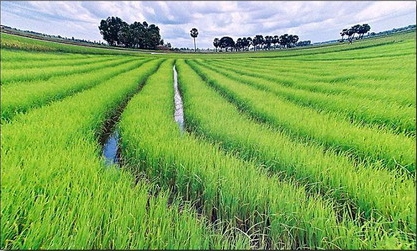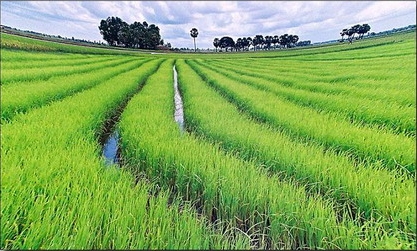Methane Released Form Paddy Fields Second Largest Source of Global Warming Gases

A new type of rice paddy developed from genetic modifications, would help reduce global warming.
A recent article published in the Science Magazine revealed that a group of international scientists, working in China, have developed a new type of genetically modified rice that could boost food sustainability without adding to global warming. The trials on this were carried out for three years.
However this development has further fueled controversy and heated debates over genetically modified crops and crop seeds.
After fossil fuel, gases released by paddy fields are the second largest source for global warming. Paddy fields add to global warming by emitting methane gas into the atmosphere. Methane is one of the major sources of global warming gas. It is believed that methane constitutes one fifth of the gases that is responsible for global warming.
Paddy fields release methane into the atmosphere due to the application of large quantities of nitrogen fertilizers to the plants for better growth and high yields and for pest control.
The amount of methane released into the atmosphere from paddy fields differs from one region to another. Apart from the amount of nitrogen based fertilizers used, the differences in average temperature, water depth and the length of time that the rice paddy soil is waterlogged creates differences in the amount and rate of methane gas released. The emission also depends on particular periods of the year when there is paddy cultivation.
According to reports, the genetically modified paddy that has DNA from barley emits as little as 1% of the methane compared to conventional paddy crops. The report also talks about possible increase in productivity per plant resulting from suing the genetically modified crop seed.
The group of scientists who made the discovery was led by Chuanxin Sun who is a plant biochemist at Swedish University of Agricultural Sciences. The project was undertaken together with Chinese and American scientists.
“This is the first example, to our knowledge, of such a rice. Approaches to increase rice productivity and reduce methane emissions as seen in SUSIBA2 rice may be particularly beneficial in a future climate with rising temperatures resulting in increased methane emissions from paddies,” claimed the team of scientists who made the discovery.
Paul West, lead scientist for the Global Landscapes Initiative at the University of Minnesota’s Institute on the Environment said that the new rice would be ideal to generate more yields and reduce global warming at the same time.
The scientists who made the discovery however maintained that the much work would be required to be done to ascertain that the new crop holds up in realistic field trials.
There are however certain ethical issues concerning the discovery. There has always been some degree of resentment to genetically modified crops. There are claims that using genetically modified crops can result in monopoly of a few and thus create discord in production.
It is noteworthy that in China itself, adopting genetically modified crops is a sensitive issue. The authorities of the country have not allowed even a single genetically modified rice variety into its fields and hence the fate of the new discovery is still unknown as far as China is concerned.
(Source:www.forbes.co, www.ghgonline.org & www.sciencedaily.com)
A recent article published in the Science Magazine revealed that a group of international scientists, working in China, have developed a new type of genetically modified rice that could boost food sustainability without adding to global warming. The trials on this were carried out for three years.
However this development has further fueled controversy and heated debates over genetically modified crops and crop seeds.
After fossil fuel, gases released by paddy fields are the second largest source for global warming. Paddy fields add to global warming by emitting methane gas into the atmosphere. Methane is one of the major sources of global warming gas. It is believed that methane constitutes one fifth of the gases that is responsible for global warming.
Paddy fields release methane into the atmosphere due to the application of large quantities of nitrogen fertilizers to the plants for better growth and high yields and for pest control.
The amount of methane released into the atmosphere from paddy fields differs from one region to another. Apart from the amount of nitrogen based fertilizers used, the differences in average temperature, water depth and the length of time that the rice paddy soil is waterlogged creates differences in the amount and rate of methane gas released. The emission also depends on particular periods of the year when there is paddy cultivation.
According to reports, the genetically modified paddy that has DNA from barley emits as little as 1% of the methane compared to conventional paddy crops. The report also talks about possible increase in productivity per plant resulting from suing the genetically modified crop seed.
The group of scientists who made the discovery was led by Chuanxin Sun who is a plant biochemist at Swedish University of Agricultural Sciences. The project was undertaken together with Chinese and American scientists.
“This is the first example, to our knowledge, of such a rice. Approaches to increase rice productivity and reduce methane emissions as seen in SUSIBA2 rice may be particularly beneficial in a future climate with rising temperatures resulting in increased methane emissions from paddies,” claimed the team of scientists who made the discovery.
Paul West, lead scientist for the Global Landscapes Initiative at the University of Minnesota’s Institute on the Environment said that the new rice would be ideal to generate more yields and reduce global warming at the same time.
The scientists who made the discovery however maintained that the much work would be required to be done to ascertain that the new crop holds up in realistic field trials.
There are however certain ethical issues concerning the discovery. There has always been some degree of resentment to genetically modified crops. There are claims that using genetically modified crops can result in monopoly of a few and thus create discord in production.
It is noteworthy that in China itself, adopting genetically modified crops is a sensitive issue. The authorities of the country have not allowed even a single genetically modified rice variety into its fields and hence the fate of the new discovery is still unknown as far as China is concerned.
(Source:www.forbes.co, www.ghgonline.org & www.sciencedaily.com)





